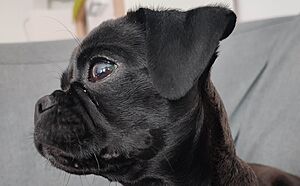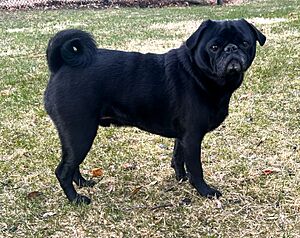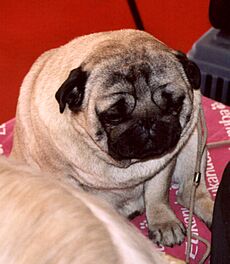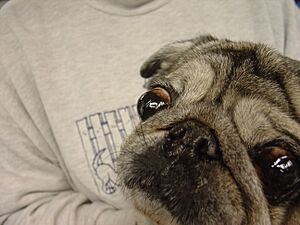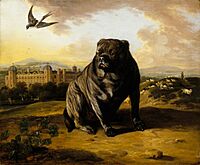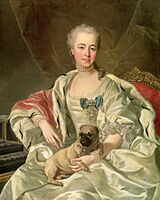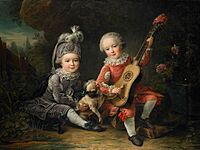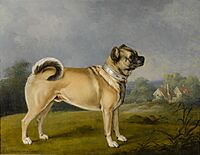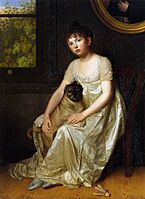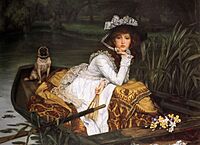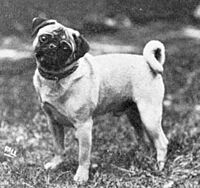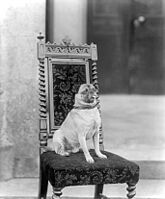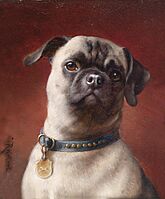Pug facts for kids
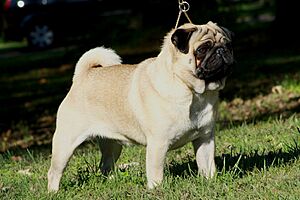
A fawn-colored pug, the most common coloring.
|
|||||||||||||||||
| Origin | China | ||||||||||||||||
|---|---|---|---|---|---|---|---|---|---|---|---|---|---|---|---|---|---|
|
|||||||||||||||||
|
|||||||||||||||||
| Domestic dog (Canis lupus familiaris) | |||||||||||||||||
The Pug is a breed of dog with a special look. They have a wrinkly, short face and a curled tail. Pugs are a very old breed, going back to about 400 BC! They have a fine, shiny coat that comes in colors like light brown (called fawn) or black. Pugs have a strong, square body.
Pugs came from China to Europe in the 1500s. They became popular in Europe thanks to royal families like the House of Orange in the Netherlands. In the 1800s, Queen Victoria in the United Kingdom loved Pugs. She helped make them popular with other royal family members too.
Pugs are known for being friendly and gentle companion dogs. The American Kennel Club says Pugs are "even-tempered and charming." Pugs are still popular today, and some famous people own them. However, Pugs can have some health problems because of how they are bred.
Contents
What Does "Pug" Mean?
There are a few ideas about where the name "Pug" came from. Some people think the breed was named after a type of monkey called a "Pug-monkey." This monkey was a popular pet in the 1700s. The Pug dog might have gotten its name because its flat face looked a bit like a monkey's.
Another idea is that the name comes from the Latin word "pugnus," which means "fist." Early Pugs sometimes had their ears trimmed. Some believe this made their head look like a closed fist from the side.
The Oxford English Dictionary says the word "pug" for the dog breed comes from an older meaning. This meaning was "a small animal" or "an imp." Since the late 1500s, "pug" has been used to describe small animals like squirrels or foxes. The term "Pug-dog" was first used in 1749.
Pug Appearance
How Pugs Look Today
Pugs shown in old pictures from the 1700s looked long and thin. But today, people prefer Pugs to have a square, strong body. They should have a deep chest and good muscles. Their smooth, shiny coats can be fawn, apricot fawn, silver fawn, or black. They often have a black line down their back. Their tail usually curls tightly over their hip.
A Pug's face is blunt and very short. This makes their head look square.
Pugs have two main ear shapes: "rose" and "button." "Rose" ears are smaller and fold with the front edge against the side of the head. "Button" ears are the preferred style for breeding.
Pugs have strong, straight legs that are not too long. Their feet are small with well-separated toes and black nails. Their lower teeth usually stick out more than their upper teeth, which is called an under-bite.
Pug Personality
The American Kennel Club says the Pug's motto is a Latin phrase: multum in parvo. This means "much in little" or "a lot of dog in a small space." Pugs are often good at sensing how their owners feel. They usually want to make their owners happy. Pugs love to play and enjoy being with people. They are often called "shadows" because they follow their owners around. They love attention and affection.
Pug History
Pugs from China
The Pug's ancestor was a dog called the Lo-Chiang-Sze, or Lo-Sze. This name described a dog with short legs, a short snout, and a short coat. This helped tell it apart from the Pekingese, which looked similar. Many people today call it the "ancient pug."
The Lo-sze was popular in the Chinese royal court during the Song dynasty. It was brought from China to Europe in the 1500s by the Dutch East India Company. Other dogs, like the Happa, might have also helped create the modern Pug. Happa dogs were brought to Europe later, around 1860. This happened when French and British soldiers took them from the Old Summer Palace in Beijing.
In ancient China, Pugs were bred to be companions for royal families. Chinese emperors loved their Pugs very much. These royal dogs lived in luxury and were guarded by soldiers. Pugs later spread to other parts of Asia. In Tibet, Buddhist monks kept Pugs as pets in their monasteries. Pugs have always been very devoted to their owners.
Pugs in Europe (1500s-1700s)
Pugs became popular in European royal courts. In 1572, a Pug named Pompey reportedly saved the life of the Prince of Orange. He warned the prince about attackers. After this, the Pug became the official dog of the House of Orange.
A Pug traveled with William III and Mary II when they became rulers of England in 1688. Around this time, Pugs might have been bred with an old type of King Charles Spaniel. This could be why the modern King Charles Spaniel has some Pug-like features.
The breed became popular in other European countries too. Famous artist Goya painted Pugs in Spain. In Italy, Pugs rode in private carriages, wearing clothes that matched their coachmen. Pugs were also used by the military to track animals and people. They even worked as guard dogs.
Pugs from the 1700s to the 1900s

The English painter William Hogarth loved Pugs. His 1745 self-portrait, now in London's Tate Gallery, shows him with his Pug, Trump. Pugs were also well-known in Italy. In 1789, a writer named Hester Piozzi wrote that every carriage she saw in Padua had a Pug in it.
Pugs continued to spread in France during the 1700s. Before she married Napoleon Bonaparte, Joséphine had a Pug named Fortune. Fortune carried secret messages to her family when Joséphine was in prison. Fortune was the only one allowed to visit her.
In 1800s England, Pugs became even more popular because Queen Victoria loved them. She bred many Pugs herself, including Olga, Pedro, and Venus. Her love for dogs helped start The Kennel Club in 1873. Queen Victoria preferred apricot and fawn Pugs. Her passion for Pugs was shared by other royals, like her grandson King George V.
In paintings from the 1700s and 1800s, Pugs usually had longer legs and noses than they do today. Sometimes their ears were cropped (trimmed). This was done in Europe to make the wrinkles on their forehead stand out more. A special set of wrinkles that looked like the Chinese symbol for "prince" (王) was very desired.
Around this time, two main types of Pugs became known in Britain: the Morrison and Willoughby lines. Morrison Pugs were more like today's Pugs, with shorter snouts.
The modern Pug's look likely changed after 1860. This was when new Pugs were brought to England by French and British soldiers. These soldiers took them from the Old Summer Palace in Beijing. These Pugs were called "Happa dogs" or "Pekingese pugs." They had shorter legs, the modern Pug nose, and were often black and white.
Two famous Happa dogs brought to England were "Moss" and "Lamb." They were bred together to create "Click." "Click" was a popular stud dog and was bred with both Willoughby and Morrison Pugs. This helped combine the two types of Pugs.
During this time, some Pugs were reportedly bred with English Bulldogs. This was to make certain traits stronger, but it made Pugs less small. Pugs with wider heads and flatter snouts came from these mixed pairings. However, some of them were not as gentle as typical lap dogs.
A British noblewoman, Lady Brassey, also helped make black Pugs popular. She brought some back from China in 1886.
Pugs arrived in the United States in the 1800s. They quickly became popular as family pets and show dogs. The American Kennel Club recognized the breed in 1885. The Pug Dog Club of America started in 1931. In 1981, a Pug named Dhandys Favorite Woodchuck won the Westminster Kennel Club Dog Show. This is the only Pug to win there since the show began in 1877.
Pugs in the 2000s
In 2004, a Pug named Double D Cinoblu's Masterpiece won the World Champion title at the World Dog Show in Rio de Janeiro.
Retro Pugs
Over time, Pugs were bred to have even shorter snouts and legs. This led to some health problems. In 2023, the Netherlands put limits on breeding certain short-faced dogs, including the usual Pug. Since about 2006, some breeders have started a trend called "retro pugs." These breeders want Pugs with longer snouts, less bulging eyes, straighter legs, and fewer face wrinkles.
Pug Health Problems
Breathing Issues (Brachycephaly)
Pugs have short snouts and flat faces. This is called brachycephaly. Because of this, they can have problems with their eyes, like scratches on their corneas. Their short snouts also make it hard for them to breathe. This can lead to noisy breathing, gagging, and skin problems in their wrinkles.
Pugs can also get too hot easily because they can't cool down well by panting. Traveling in hot airplane cargo can make their breathing problems worse. Because of this, some airlines have stopped carrying Pugs or have rules about when they can fly.
Weight Problems (Obesity)
A study in the UK found that Pugs are more likely to become overweight than other dog breeds. They are three times more likely to be obese. About one in five Pugs is diagnosed as obese each year. Being overweight is a big health concern for Pugs. It can cause other health problems, but it can also be fixed.
How Long Pugs Live
A UK study of vet records showed that Pugs live for about 7.65 years. This is less than the average dog, which lives about 11.23 years. Another UK study found Pugs live about 11.6 years, compared to 12.7 years for purebreds. A study in Japan found Pugs live about 12.8 years.
Limited Gene Pool
In 2008, a TV show found that many purebred dogs, including Pugs, were very closely related. A study showed that the 10,000 Pugs in the UK had a gene pool like only 50 individual humans. This means there isn't much variety in their genes.
Other Health Issues
Pugs can have hip dysplasia. This is when the hip joint doesn't form correctly. A 2010 survey found that almost 64% of Pugs had this problem. Pugs were the second-worst breed for this condition out of 157 breeds tested.
Pugs are also more likely to get a skin condition called demodicosis.
Pugs can suffer from necrotizing meningoencephalitis (NME), also called Pug Dog Encephalitis (PDE). This is when their brain becomes inflamed. NME also happens in other small dogs like Yorkshire Terriers and Chihuahuas. It affects about 1-2% of all Pugs.
Pugs are prone to hemivertebrae. This is a problem with their spine that can cause pain and weakness in their back legs.
A UK study found Pugs were much more likely to have problems with blood flow to their liver.
Birth and Puppies
Pug puppies often have large heads compared to their mother's birth canal. Because of this, Pugs often need to have their puppies delivered by C-section (surgery).
Pugs in Art Through History
-
A portrait of Princess Ekaterina Golitsyna by Louis-Michel van Loo (1759)
Moscow, Pushkin Museum of Fine Arts -
Young Lady in a Boat with a Pug by James Tissot, 1870
See also
 In Spanish: Pug para niños
In Spanish: Pug para niños
- Companion dog
- Lap dog
- Order of the Pug
- Canis





